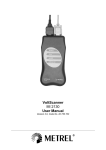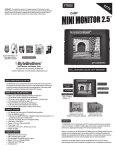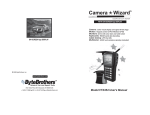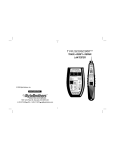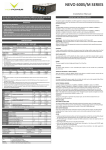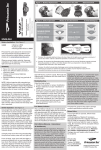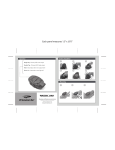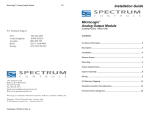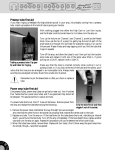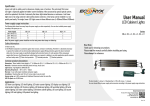Download CTX590 - Triplett
Transcript
CONTINUITY MODE (set power switch to CONTINUITY) CONT: Test wire pair for continuity RED/GREEN LED Use this mode to detect whether a pair of wires has continuity. This test does not require the use of the probe. How to test for continuity using the CTX590 1. Pick the pair of wires you wish to test for continuity. 2. Place the switch in the CONTINUITY position. 3.Attach the tone to the wires using either the RJ11, RJ45 or the alligator clips. 4.If the Red/Green LED lights, continuity exists on the pair. Note: You can verify whether you are in CONTINUITY mode by touching the alligator clips together. Remember, if continuity exists across two conductors purposely, it is called "bridging". If it is not by design, it is called a "short" circuit. RED/GREEN LED CHART Voltage, polarity and continuity tests: The Red/Green LED is active in all three switch positions. See the following chart for the LED's meaning: The Red/Green LED indicates voltage, polarity and continuity LED color Red Green Alternating Tone Positive voltage Negative voltage AC voltage Switch position Off Positive voltage Negative voltage AC voltage Continuity Yes NA NA TM WIRE LOCATOR ALL WIRE TYPES MODEL CTX590 In the TONE mode, the tone itself causes the red/green LED to indicate AC voltage (the tone itself is an AC signal). So, for voltage/polarity tests, use the OFF position. How to determine polarity: Positive voltage on the red clip in relation to black clip is positive polarity; as is pin 3 in relation to 4 (RJ11); and pin 4 in relation to 5 (RJ45). When checking telephone polarity, a green LED is correct telephone polarity and a red LED is reversed polarity. Detect telephone and modem connections using the Red/Green LED Phone pairs have a “tip” (0V) and a “ring” (-48VDC). Phones and modems typically use the center pair of the connector (pins 4,5 in an 8 position (RJ45) jack or pins 3, 4 in a 6 position jack). 1) Connect the tone generator to the wall outlet using the RJ11 or RJ45 plug. 2) If the LED lights, a connection could exist. A negative polarity is normal for pins 4 and 5 (polarity is a concern with some digital systems). Network Test and Certification 7003 132nd Place SE, Newcastle,WA 98059 USA +1.425.917-8380 ● FAX +1.425.917-8379 ● www.bytebrothers.com Network Test and Certification TONE MODE (set power switch to TONE) RED/GREEN LED 9V BATTERY TONE SWITCH: Select steady or alternating tone (inside case) TONE: Send tone OFF: Voltage detector CONT: Continuity test The CTX590 Toner/Probe is a high quality wire locating tool that uses an inductive probe to sense a tone placed on the wires by its associated tone generator. Plus, the tone generator's red/green LED indicator senses voltage and continuity, so the CTX590 is useful for tracking down short circuits, telephone central office connections, polarity and continuity. Because the red/green LED is always active (regardless of switch position), it can be very informative. See the "Red/Green LED" chart on the back for details. ● To locate the end of a pair of wires, even when the conductors are in a wiring bundle, see the TONE instructions. ● To find breaks in conductor(s), see the TONE instructions. ● To test a pair of wires for continuity (shorts), see the CONTINUITY instructions. ● To test for the presence/polarity of voltage on a pair of conductors...such as telephone levels, see the Red/Green LED chart instructions. CAUTION Telephones employ a battery voltage of -48VDC for “Ring”. When the telephone circuit is ringing, the voltage will be much higher (90VRMS on top of the -48VDC). Be careful not to touch any exposed conductors. Use all of the normal precautions associated with installing or repairing telephone equipment. TONE: Send tone When in Tone Mode, the ProTone sends a tone to a pair of conductors. You detect the tone using the Probe How to locate wires with the CTX590 1.Place the Power Switch in the TONE position. 2.Pick the pair of wires you wish to trace. 3.Apply the tone to the wires using either the RJ11, RJ45 or the alligator clips. 4.Trace the tone using the Probe Note: The tone generator can send a steady or an alternating tone. The selector switch is inside the tone generator case. Factors affecting Tone Volume and Traceability ● Tracing tone is best on wires not connected to a power source. Existing signals can interfere with the tone signal. ● The tone is always louder at the cable end (not along the cable run). ● If you are tracing a tone and the volume drops, you may have detected a break in one or both of the conductors. ● Change the battery(s) when you suspect a weaker than normal tone. TONE MODE (using the probe) The ProTone filtered probe detects the tone from the Tone Generator Ultrabright LED shines from the tip of the probe Volume control is on the back of the probe Activates the probe's circuitry and ultrabright LED on the tip. The "tone" LED is a visual indication that the tone generator's tone is detected. "60HZ" LED warns that 60HZ (AC voltage) is present and should be avoided 9V battery The red button activates tone sensing and lights the ultrabright LED. Place the tip of the probe across the cable at various angles until you get the loudest signal. Filtering eliminates much of the fluorescent hum from lighting. Use the 60HZ LED for safety and the tone LED for silent operation. Battery: Replace when 1) the tone is very weak or 2) the probe continually squeals.




